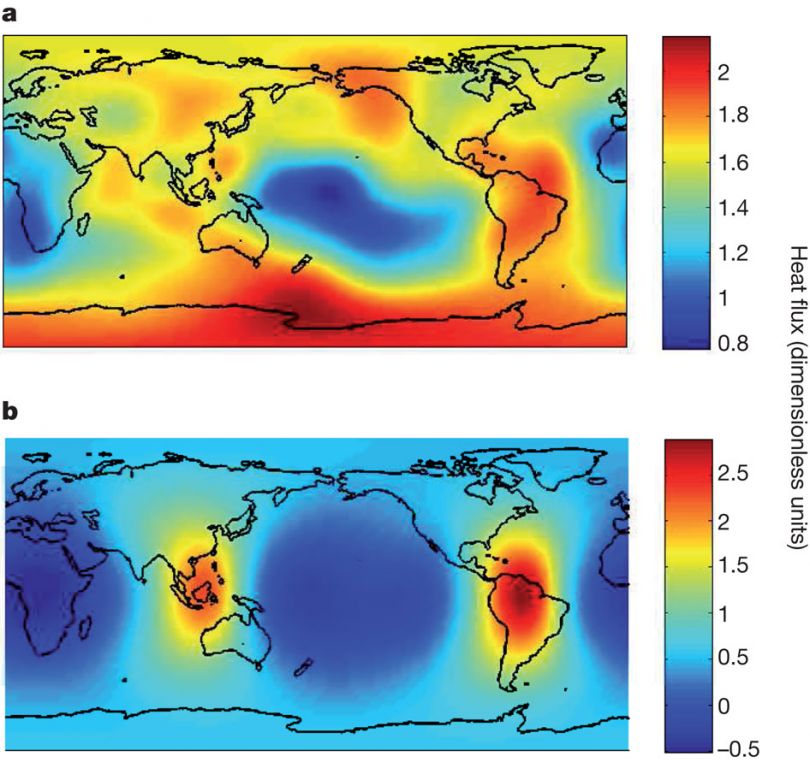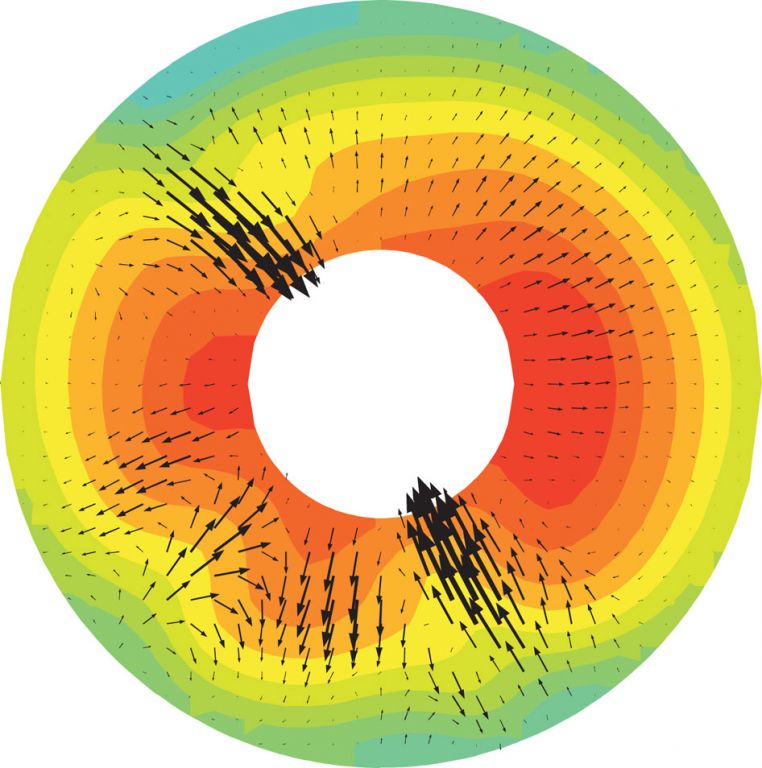博文
地球内核的熔融作用 Melting of the Earth’s inner core
|||
地球内核的熔融作用 Melting of the Earth’s inner core
David Gubbins, Binod Sreenivasan, Jon Mound & Sebastian Rost
地球的磁场是由液态铁核发电机产生的,它对应着上覆岩石地幔的冷却而对流着。地核由最里面向外冷却,生成固态的内核并释放驱动成分对流动轻元素(1-3)。地幔对流从地核中提取热量,其速率具有极大的侧向差异性(4)。本文我们利用地球发电机(geodynamo模拟表明这些差异性转移到了内核边界处并足以引起向内核的热流。如果这发生在地球内部的话,将引起局部熔融作用。熔融作用所释放的较重的流体可以形成一个多成分层,该层已经由内核边界150km之上的地震波速异常观测所揭示出来(5-7)。本研究为该层的存在提供了一个简明的解释,否则这将需要另外一些假说来解释,如内核对地幔的锁定(locking),重力势能中心的转换(7,8),或者是与固相线温度相同但成分从外核到内核之间变化的对流作用(9)。这些明显的与冷却相关的较细的下降流和与熔融相关的大量的上升流表明,熔融区域可能相当广泛,尽管保持地球发电机运行的冷却作用占据平均优势。局部熔融与冷却作用同样也为内核自身的地震波异常提供了一种有效机制,这比目前所考虑到热流差异作用(10)更加强有力一些。
Nature原文链接:http://www.nature.com/nature/journal/v473/n7347/full/nature10068.html
PDF下载:2011-Nature-Melting of the Earth's inner core.pdf
Nature同期有一篇介绍文章:http://www.nature.com/nature/journal/v473/n7347/full/473292a.html
(以下是原文翻译,译者周春银)
地核只是被动地响应着地幔引起的不规则热流活动:它在这个耦合对流体系中扮演的是一个完全被动的角色。地幔对流所产生的核幔边界(core-mantle boundary, CMB)附近热流活动的差异性可能是巨大的。他们可以通过两种独立的方法来估计,一种是利用在假定的地幔底部的热边界层内的地震层析成像(seismic tomography)(11),另一种是利用地幔对流研究(4)。两者均显示与平均热流相当的差异性。不均匀边界条件对核对流(core convection)(12-14)会产生巨大的影响,并且当背景对流(background convection)很小时,边界差异可以通过增强流体柱中的螺旋形运动来促进磁场的形成(15)。许多地球发电机模拟基于地震层析成像研究,利用热边界条件来解释地磁场的非轴对称时间平均值(16-18)、太平洋地区的低长期变化(16,19)、极性倒转的频率(20)、以及倒转过程中固有的极性转换途径(21)。

Figure 1: Effect of mantle inhomogeneity on heat flux distribution at the inner core surface. Heat fluxes are applied to the upper boundary (a) and calculated on the constant-temperature lower boundary (b) in a geodynamo simulation where the flow is strongly coupled to the boundary thermal anomalies (q* = 0.45). The range of heat flux across the upper boundary ranges from 0.77 to 2.16 dimensionless units outwards and across the lower boundary ranges from −0.51 to 2.89 dimensionless units (negative values indicate heat flux into the inner core). This model uses an Ekman number 1.2 × 10−4, Rayleigh number 1.5 times the critical value for onset of convection, Prandtl number 1 and magnetic Prandtl number 10. (See the Methods section for definitions of these dimensionless numbers.)
我们根据由不均匀上边界热流和恒定下边界温度所驱动的数字地球发电机计算来研究内核边界(inner-core boundary, ICB)处的热流变化。有关我们发电机模型的详细介绍见Methods材料。利用层析成像边界条件(11)的样本足以说明下边界处向内的热流存在的可能性。重要参数q* = (qmax-qmin)/(2qmean) 计算了相对平均值而言CMB热流侧向变化的强度;q* = 0.15-0.45这一范围得出的发电机模型,包括从相对未受边界条件影响的模型,到其中磁场几乎是静止的或者从统计学上说是“锁定”在边界的模型(22)。

Figure 2: Calculated heat flux on the lower boundary of a geodynamo model where q* = 0.15 for the upper boundary heat flux. Panels a and b are snapshots and c shows the time average over several magnetic diffusion times. Heat fluxes range from −0.287 to 2.126 (a), −0.124 to 1.976 (b) and −0.276 to 1.86 (c) for the time average. The parameters used in this model are the same as in Fig. 1.
Figure 1显示了在q*=0.45时锁定的发电机模型中上下边界处的热流分布。ICB和CMB处的热流图像是成镜像的;热流负斑块指示熔融位置处向内核的热流,如果这是模型的一部分。Figure 2显示了在q*=0.15时的发电机模型的两幅快照以及时间平均值;仍然存在负热流斑块,尽管侧向变化很弱。在所有这些模型中,外核中的上升流分布很广,而下降流则垂直很细(Fig 3),形成高CMB热流之下高ICB热流的集中斑块。熔融区域因此相对于熔融的总量来说是相对比较大的。但是我们也注意到,具有不同运行参数和浮力关系的发电机模型并不需要产生向下边界的热流活动:一个较弱的对流区域可能最有利于内核熔融作用,其中上边界处的侧向变化可以通过各种方式传播到下边界。

Figure 3: Temperature (colour contours) and fluid flow (arrows) on the equatorial section for the statistically locked tomographic model (q* = 0.45). The lowest temperature is blue and the highest temperature is deep red. We note the narrow downwellings beneath cold regions (the two major ones coinciding with the ‘ring of fire’ around the Pacific) and broad upwellings (corresponding to the mid-Pacific and African superplume). This leads to relatively large areas of negative (melting) and low-positive heat flux on the ICB and relatively small areas of strong-positive heat flux (freezing).
当将热地球发电机模拟结果运用到地球时有三个负责因素必须考虑。第一个就是传播到绝热线下的热量。这在最近的一项地幔对流研究中被忽视掉,该研究考察了后钙钛矿(postperovskite)层和化学成分变化对贯穿CMB的热流活动的影响作用,以及它和地震剪切波速的相关性(4)。后钙钛矿对热流影响甚微但是对化学成分侧向变化影响较大,例如覆盖在CMB之上的深俯冲板块会极大地增大q*值。要将这些结果运用到地核对流中,我们必须首先去除传播到绝热温度梯度以下的热量。根据对CMB绝热梯度(1 K/km)和地核热导率(k=50 W m-1K-1) 的典型估计值,传播的热量为50 m W m-2,与地幔对流计算qmean值相当。去除这一热量将大大提高q*,因为这会降低qmean到几乎零值而qmax-qmin不变化。实际上这里没有什么可以阻止q*变得无限大,正如在前人研究的最接近真实的地幔模型中(TC-3.6模型,具有可变的辉石含量)(4)的一样,这意味着地核顶部是热中立的(neutral)。大多数发电机模拟都受限于非常低的q*值,发电机模型不能解释广泛的侧向热流变化(15,18)。在我们具有内部加热作用的模型中发电机模型q*≈1也无法解释,但是具有基底加热和分层上层的发电机模型具有较大的q*仍然可以有效解释(ref.23)。地球液核的上部区域可能是稳定分层的,或者最多仅有非常微弱的对流(24,25),因此对于地球来说可能应具有高q*值。有两个因素可能会随深度而增大q*。首先绝热梯度在CMB和ICB之间会随深度而减少3倍。在ICB绝热热量必须加回到模型结果中,减少任何进入内核的热流;但是减弱的绝热线使得这种效应相对非常微弱。其次,较细的下降流和球形结构倾向于会集中对流热量,增大侧向差异性。
第二个要考虑的复杂因素是化学成分对流。成分梯度是中立的或者说在CMB是稳定的(假设没有轻元素进入到地幔中):地核顶部的对流纯粹是热力学上的。成分浮力在外核深部逐渐会主导热浮力作用,尤其是在ICB附近,如下面的计算所显示的一样。浮力表达为ρ(αcc+αTT)g,这里ρ是密度,g是重力加速度,αT是热膨胀系数,αc是成分膨胀系数。成分变化因此具有等价热αc/αT。对比在各自的扩散方程中的热流和质量流发现,转换因子是Cpαc/αT,这里Cp是比热。在ICB凝固1kg的液体释放L焦耳的潜热和ρc kg的质量以及等加热Cpαcc/αT焦耳。在浓度(concentration) c=0.0252的情况下,这对应着ICB处0.6g/cm3的密度突变(来自PREM模型(26)),假设其中有0.34g/cm3来自于纯铁的固-液相变(27),那么有效浮力比Cpαcc/LαT=2.3。在更大的ICB密度突变情况下成分浮力将会起主导作用甚至更大:0.8 g/cm3时为4.1,1.0 g/cm3时为5.8。因此在ICB附近温度变化在浮力中的作用相对而言不是很重要,但是对于确定凝固速率以及通过释放轻元素来提供浮力作用来说很重要。上边界所产生的侧向温度变化将会通过成分对流以及辅助的热对流作用一直传播到ICB,所以我们预计在热力学或同密度(codensity)地球发电机模拟中所观测到ICB处的差异将会在一个热-化学体系中维持稳定。
第三个复杂因素就是多成分层可能的动力学影响。贯穿新熔的、重流体层的密度梯度比外核主体部分对流所产生的任何东西都大很多:150-km这一层的密度变化为0.1 g/cm3,而在相类似或更长范围内典型的对流密度波动为10-6g/cm3或更低,这是根据ICB附近浮力-科里奥力平衡估计出来的(28)。这样大的密度梯度将会阻止下降流到达ICB,但是由凝固所产生的轻物质上升流(plume)将会穿越它,沿ICB向着凝固地区留下重流体并维持多成分层的混合作用。实验研究表明,如果熔融超过20%的凝固(8)上升流将会与该层混合,但是ICB上的上升流是由热效应所决定的而不是化学成分效应。还需要进一步的研究来认识这一层的作用。
CMB处热流变化所形成的内核的区域性熔融作用,为外核底部所观测到的多成分层提供了简明解释。这同样也为固体内核本身的地震异常提供了一个有效的机制解释,因为熔融区域将会由最近产生的、预压过的物质所组成,而凝固区域将会含有最近形成的、松散物质层。热流差异性已经被用来解释内核的地震波异常(29),但是实际的熔融作用将会产生更强的作用(7)。在两种情况下,地幔异常和保持位置的任何相关性都需要内核,在某种程度上整个地核,流动都锁定于地幔。如果这些观测能够与进一步的观测相容,尤其是如果多成分层最终并不需要内核锁定,他们将为地核演化、对流以及发电机提供重要的约束条件。
参考文献:
1. Braginsky, S. I. Structure of the F layer and reasons for convection in the Earth’s core. Dokl. Akad. Nauk. SSSR (Engl. Trans.) 149, 1311–1314 (1963) Show context
2. Labrosse, S., Poirier, J.-P. & Le Mouël, J.-L. On cooling of the Earth’s core. Phys. Earth Planet. Inter. 99, 1–17 (1997) ISI Article Show context
3. Nimmo, F., Price, G. D., Brodholt, J. & Gubbins, D. The influence of potassium on core and geodynamo evolution. Geophys. J. Int. 156, 363–376 (2004) ChemPort Article Show context
4. Nakagawa, T. & Tackley, P. J. Lateral variations in CMB heat flux and deep mantle seismic velocity caused by a thermal-chemical-phase boundary layer in 3D spherical convection. Earth Planet. Sci. Lett. 271, 348–358 (2008) ChemPort ISI Article Show context
5. Souriau, A. & Poupinet, G. The velocity profile at the base of the liquid core from PKP(BC+Cdiff) data: an argument in favor of radial inhomogeneity. Geophys. Res. Lett. 18, 2023–2026 (1991) ISI Article Show context
6. Song, X. D. & Helmberger, D. V. Velocity structure near the inner core boundary from waveform modeling. J. Geophys. Res. 97, 6573–6586 (1992) ISI Article Show context
7. Monnereau, M., Calvet, M., Margerin, L. & Souriau, A. Lopsided growth of Earth’s inner core. Science 328, 1014–1017 (2010) ChemPort ISI PubMed Article Show context
8. Alboussière, T., Deguen, R. & Melzani, M. Melting-induced stratification above the Earth’s inner core due to convective translation. Nature 466, 744–747 (2010) ChemPort ISI PubMed Article Show context
9. Gubbins, D., Masters, G. & Nimmo, F. A thermochemical boundary layer at the base of Earth’s outer core and independent estimate of core heat flux. Geophys. J. Int. 174, 1007–1018 (2008) Article Show context
10. Aubert, J., Amit, H. & Hulot, G. Detecting thermal boundary control in surface flows from numerical dynamos. Phys. Earth Planet. Inter. 160, 143–156 (2007) ISI Article Show context
11. Masters, T. G., Johnson, S., Laske, G. & Bolton, H. F. A shear-velocity model of the mantle. Phil. Trans. R. Soc. Lond. A 354, 1385–1411 (1996) Article Show context
12. Zhang, K. & Gubbins, D. Convection in a rotating spherical fluid shell with an inhomogeneous temperature boundary condition at finite Prandtl number. Phys. Fluids 8, 1141–1148 (1996) ChemPort ISI Article Show context
13. Zhang, K. & Gubbins, D. Scale disparities and magnetohydrodynamics in the Earth’s core. Phil. Trans. R. Soc. Lond. A 358, 899–920 (2000) Article Show context
14. Gibbons, S. & Gubbins, D. Convection in the Earth's core driven by lateral variations in the core-mantle boundary heat flux. Geophys. J. Int. 142, 631–642 (2000) ISI Article Show context
15. Sreenivasan, B. On dynamo action produced by boundary thermal coupling. Phys. Earth Planet. Inter. 177, 130–138 (2009) Article Show context
16. Bloxham, J. The effect of thermal core-mantle interactions on the paleomagnetic secular variation. Phil. Trans. R. Soc. Lond. A 358, 1171–1179 (2000) Article Show context
17. Christensen, U., Olson, P. & Glatzmaier, G. A. A dynamo model interpretation of geomagnetic field structures. Geophys. Res. Lett. 25, 1565–1568 (1998) ISI Article Show context
18. Olson, P. & Christensen, U. R. The time-averaged magnetic field in numerical dynamos with non-uniform boundary heat flow. Geophys. J. Int. 151, 809–823 (2002) ISI Article Show context
19. Christensen, U. R. & Olson, P. Secular variation in numerical geodynamo models with lateral variations of boundary heat flow. Phys. Earth Planet. Inter. 138, 39–54 (2003) ISI Article Show context
20. Glatzmaier, G. A., Coe, R. S., Hongre, L. & Roberts, P. H. The role of the Earth’s mantle in controlling the frequency of geomagnetic reversals. Nature 401, 885–890 (1999) ISI Article Show context
21. Kutzner, C. & Christensen, U. R. Simulated geomagnetic reversals and preferred virtual geomagnetic pole paths. Geophys. J. Int. 157, 1105–1118 (2004) ISI Article Show context
22. Gubbins, D., Willis, A. P. & Sreenivasan, B. Correlation of Earth’s magnetic field with lower mantle thermal and seismic structure. Phys. Earth Planet. Inter. 162, 256–260 (2007) Article Show context
23. Sreenivasan, B. & Gubbins, D. Dynamos with weakly convecting outer layers: implications for core–mantle boundary interaction. Geophys. Astrophys. Fluid Dyn. 102, 395–407 (2008) ISI Article Show context
24. Buffett, B. A. & Seagle, C. T. Stratification of the top of the core due to chemical interactions with the mantle. J. Geophys. Res. 115, B04407 (2010) ChemPort Article Show context
25. Helffrich, G. & Kaneshima, S. Outer-core compositional stratification from observed core wave speed profiles. Nature 468, 807–810 (2010) ChemPort ISI PubMed Article Show context
26. Dziewonski, A. M. & Anderson, D. L. Preliminary Reference Earth Model. Phys. Earth Planet. Inter. 25, 297–356 (1981) Article Show context
27. Gubbins, D., Alfè, D., Masters, T. G. & Price, D. Gross thermodynamics of 2-component core convection. Geophys. J. Int. 157, 1407–1414 (2004) ChemPort ISI Article Show context
28. Moffatt, H. K. & Loper, D. E. The magnetostrophic rise of a buoyant parcel in the Earth’s core. Geophys. J. Int. 117, 394–402 (1994) ISI Article Show context
29. Aubert, J., Amit, H., Hulot, G. & Olson, P. Thermochemical flows couple the Earth’s inner core growth to mantle heterogeneity. Nature 454, 758–761 (2008) ChemPort ISI PubMed Article Show context
30. Sreenivasan, B. A buoyant flow structure in a magnetic field: quasi-steady states and linear–nonlinear transitions. Phys. Lett. A 372, 5471–5478 (2008) ChemPort ISI Article Show context
31. Sreenivasan, B. & Jones, C. A. The role of inertia in the evolution of spherical dynamos. Geophys. J. Int. 164, 467–476 (2006) Article Show context
https://blog.sciencenet.cn/blog-92454-445888.html
上一篇:地幔深部Fe的自旋态转换以及富Fe硅酸盐熔体
下一篇:最新一期《中国科学D辑·地球科学》发布“华北克拉通破坏”专辑